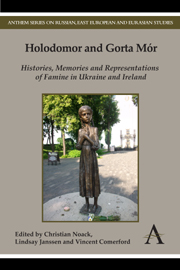Book contents
- Frontmatter
- Contents
- List of Figures
- Acknowledgements
- Introduction Holodomor and Gorta Mór: Histories, Memories and Representations of Famine in Ukraine and Ireland
- Part I Histories, Historiography and Politics
- Part II Public Commemoration
- Part III Trauma and Victimisation
- Part IV New Sources and New Approaches to the Irish and Ukrainian Famines
- Chapter 11 In Search of New Sources: Polish Diplomatic and Intelligence Reports on the Holodomor
- Chapter 12 Oral History, Oral Tradition and the Great Famine
- Chapter 13 Mapping Population Change in Ireland 1841–1851: Quantitative Analysis Using Historical GIS
- Index
Chapter 13 - Mapping Population Change in Ireland 1841–1851: Quantitative Analysis Using Historical GIS
from Part IV - New Sources and New Approaches to the Irish and Ukrainian Famines
Published online by Cambridge University Press: 05 May 2013
- Frontmatter
- Contents
- List of Figures
- Acknowledgements
- Introduction Holodomor and Gorta Mór: Histories, Memories and Representations of Famine in Ukraine and Ireland
- Part I Histories, Historiography and Politics
- Part II Public Commemoration
- Part III Trauma and Victimisation
- Part IV New Sources and New Approaches to the Irish and Ukrainian Famines
- Chapter 11 In Search of New Sources: Polish Diplomatic and Intelligence Reports on the Holodomor
- Chapter 12 Oral History, Oral Tradition and the Great Famine
- Chapter 13 Mapping Population Change in Ireland 1841–1851: Quantitative Analysis Using Historical GIS
- Index
Summary
The spatially uneven nature of the impacts of the Irish Famine have been recognised by both historians and geographers and research that has examined the Famine at various spatial scales has shed much light on its uneven impact on the human landscape of mid-1840s Ireland. However, the regionally varied nature of the event makes it difficult to understand its impacts at the national scale. This is because of the difficulty of assessing the extent to which local processes that may have contributed to the worsening of conditions for people in different areas operated at the national scale. The emphasis on local areas that characterises much of the literature on the Irish Famine in part contributes to this difficulty. We have much detailed research for particular villages, parishes, poor law unions and counties, but little comparative or national analysis. Recent research has attempted to bridge the gap between local and national perspectives on the Famine by constructing a geographical information systems (GIS) database of local attributes at electoral division (ED) level for the entire island. Electoral divisions are administrative units first introduced to Ireland in the mid-1840s for the purposes of rate collection and were also used as the unit for census data collection. There were 3,439 such divisions in Ireland at this time.
- Type
- Chapter
- Information
- Holodomor and Gorta MórHistories, Memories and Representations of Famine in Ukraine and Ireland, pp. 245 - 268Publisher: Anthem PressPrint publication year: 2012



